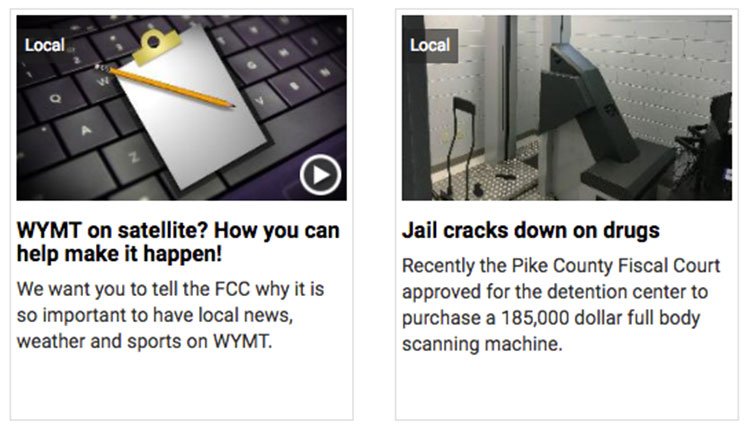Gray TV Draws Crowd to FCC Satellite Carriage Petition

Gray Television's ongoing request to modify the satellite market for its WYMT Hazard, Ky., so it can reach more in-state viewers has drawn a crowd. In fact, it has overtaken the Restoring Internet Freedom as the busiest FCC docket in terms of comments over the last 30 days with over 1,600 comments.
The FCC opened the docket on Gray's market modification request Jan. 16 and WYMT GM Neil Middleton made an on-air request for viewer input and posted a link to the FCC's comment-filing system. "No one should have to rely on a television station from another state," said Middleton in an interview for his own newscast. "With your help, we're hoping satellite carriers will add WYMT soon. The station urged viewers to contact the FCC and say: "I want my YMT."
The station told viewers they had until Feb. 5 to file as many comments as they can.
Most were on the order of: "Please allow WYMT TV to go on Satellite," or "I live 18 road miles from WYMT station and less than 5 air miles away but my local cable channels are from Tennessee. Doesn't make any common sense that it should be this way."
Gray is petitioning the FCC to add and subtract some counties now that the FCC has extended market modifications, formerly only the province of cable MVPDs, to satellite as well.
DirecTV told Gray that its spot beam was unable to add WYMT in any of the (Lexington, Ky.) counties and still have room for existing WKYT Lexington--both stations are CBS affiliates. Dish said that since it did not carry WYMT in any market, it was "not in a position to say how feasible it was to carry it in any markets outside its Nielsen DMA," according to letters Gray filed with the FCC.
Related: FCC Grants La Plata Market Modifications
Back in 2015, the FCC voted to allow satellite operators to modify their markets to carry TV stations of significant interest to their viewers.
The new rules mirrored those for cable operators, who could already import significantly viewed stations that may, for example, have been gerrymandered out of local markets due to DMAs that cross state lines. The issue was a hot-button one with legislators with football fan constituents denied the games of their local football team, for example.
"In certain multistate Designated Market Areas (“DMAs”), satellite subscribers located in out-of-state counties within a DMA are sometimes unable to receive in-state broadcast television stations and therefore may lack access to in-state news, sports, public affairs, political information, and emergency information," the FCC said at the time. "The STELAR Act (see below) addresses this so-called 'orphan county' problem by allowing the Commission to modify, upon the request of a television station, satellite operator, or county government, a particular commercial television broadcast station’s local television market to add or delete communities to better reflect market realities."
The FCC uses a multi-factor test to decide whether to grant the modification. One of those factors is feasibility. The rules allow for exceptions where it is not technically feasible--satellite operators need precisely tuned spot beams to deliver local service.
The market modification was requested by congress in the STELAR legislation renewing the satellite compulsory license.
There is a five-part test for determining market modifications:
(1) "Whether the station, or other stations located in the same area—(a) have been historically carried on the cable system or systems within such community; and (b) have been historically carried on the satellite carrier or carriers serving such community;
(2) "Whether the television station provides coverage or other local service to such community;
(3) "Whether modifying the local market of the television station would promote consumers’ access to television broadcast station signals that originate in their State of residence;
(4) "Whether any other television station that is eligible to be carried by a satellite carrier in such community in fulfillment of the requirements of this section provides news coverage of issues of concern to such community or provides carriage or coverage of sporting and other events of interest to the community; and
(5) Evidence of viewing patterns in households that subscribe and do not subscribe to the services offered by multichannel video programming distributors within the areas served by such."
The smarter way to stay on top of broadcasting and cable industry. Sign up below
Contributing editor John Eggerton has been an editor and/or writer on media regulation, legislation and policy for over four decades, including covering the FCC, FTC, Congress, the major media trade associations, and the federal courts. In addition to Multichannel News and Broadcasting + Cable, his work has appeared in Radio World, TV Technology, TV Fax, This Week in Consumer Electronics, Variety and the Encyclopedia Britannica.

